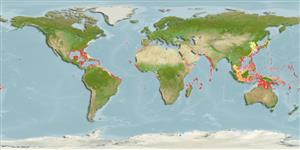Common names from other countries
>
Tetraodontiformes (Puffers and filefishes) >
Balistidae (Triggerfishes)
Etymology: Canthidermis: Greek, kanthos = the outer or inner corner of the eye, where the lids meet, 1646 + Greek, derma = skin (Ref. 45335).
More on author: Mitchill.
Environment: milieu / climate zone / depth range / distribution range
Ecología
marino asociado a arrecife; rango de profundidad 5 - 60 m (Ref. 36453), usually 5 - 30 m (Ref. 40849). Tropical; 43°N - 17°S
Western Atlantic: Massachusetts (USA), Bermuda, and northern Gulf of Mexico to South America. Eastern Atlantic: St. Paul's Rocks, Ascension, Cape Verde and St. Helena (Ref. 5288); Sao Tome Island (Ref. 34088). Stray recod from Canada (Ref. 5951).
Tamaño / Peso / Age
Maturity: Lm ? range ? - ? cm
Max length : 65.0 cm TL macho / no sexado; (Ref. 9710); peso máximo publicado: 6.1 kg (Ref. 40637)
Espinas dorsales (total) : 3; Radios blandos dorsales (total) : 25 - 28; Espinas anales: 0; Radios blandos anales: 23 - 25. Soft dorsal and anal fins very elevated anteriorly, the longest rays nearly as long as head; caudal fin double-emarginate, brownish gray with a large dark brown spot at base of pectoral fins (Ref. 13442).
Common near drop-offs of seaward reefs (Ref. 9710). Occasionally in shallow water. Solitary or in small groups in open water. Often associated with Sargassum (Ref. 9710). Feeds mainly on large zooplankton. Minimum depth reported from Ref. 13121.
Life cycle and mating behavior
Maturities | Reproducción | Spawnings | Egg(s) | Fecundities | Larva
Distinct pairing (Ref. 205).
Robins, C.R. and G.C. Ray, 1986. A field guide to Atlantic coast fishes of North America. Houghton Mifflin Company, Boston, U.S.A. 354 p. (Ref. 7251)
IUCN Red List Status (Ref. 130435)
CITES (Ref. 128078)
Not Evaluated
Threat to humans
Harmless
Human uses
Pesquerías: comercial; pesca deportiva: si; Acuario: Comercial
Herramientas
Special reports
Download XML
Fuentes de Internet
Estimates based on models
Preferred temperature (Ref.
115969): 22.7 - 28.6, mean 27.3 (based on 770 cells).
Phylogenetic diversity index (Ref.
82804): PD
50 = 0.6250 [Uniqueness, from 0.5 = low to 2.0 = high].
Bayesian length-weight: a=0.02455 (0.01549 - 0.03890), b=2.90 (2.77 - 3.03), in cm Total Length, based on LWR estimates for this species & (Sub)family-body (Ref.
93245).
Nivel trófico (Ref.
69278): 3.5 ±0.3 se; based on diet studies.
Resiliencia (Ref.
120179): Medio, población duplicada en un tiempo mínimo de 1.4-4.4 años (Preliminary K or Fecundity.).
Fishing Vulnerability (Ref.
59153): Low to moderate vulnerability (34 of 100).
